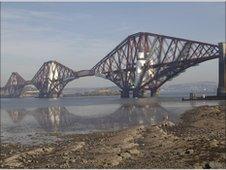Forth Bridge seeks world heritage status
- Published

Forth Bridge is one of the Scottish bids for World Heritage Status in 2012
The Forth Bridge and Shetland's Iron Age settlements are among six Scottish bids for World Heritage site status.
Thirty-eight UK places are competing to be recognised by United Nations' cultural body Unesco.
The other Scottish bids include Arbroath Abbey, where the Declaration of Arbroath was signed in 1320.
The Flow Country of Caithness and Sutherland, St Andrews in Fife and the buildings of Charles Rennie Mackintosh in Glasgow are also bidding.
Offa's Dyke and the city of York are among the 38 UK sites put forward.
The UK government will submit a final list next year with a view to making six nominations in 2012.
St Kilda, Edinburgh's Old and New towns, Neolithic Orkney and New Lanark are part of the existing list of 800 sites worldwide.
UK tourism and heritage minister John Penrose said: "The UK's heritage is world class and this list represents the unique variety and history present in all corners of this country."
He added: "Any list that includes Jodrell Bank, the Forth Bridge, Blackpool and the Turks and Caicos Islands certainly doesn't lack variety.
"But what all 38 sites have in common is a wow factor and a cultural resonance that makes them real contenders to sit alongside The Pyramids and Red Square in this most distinguished of gatherings."
There are currently more than 800 World Heritage sites, including the Taj Mahal, the Great Wall of China and the Statue of Liberty.
- Published28 May 2010